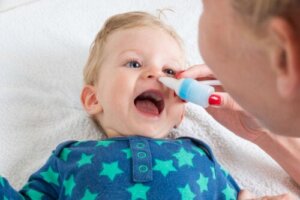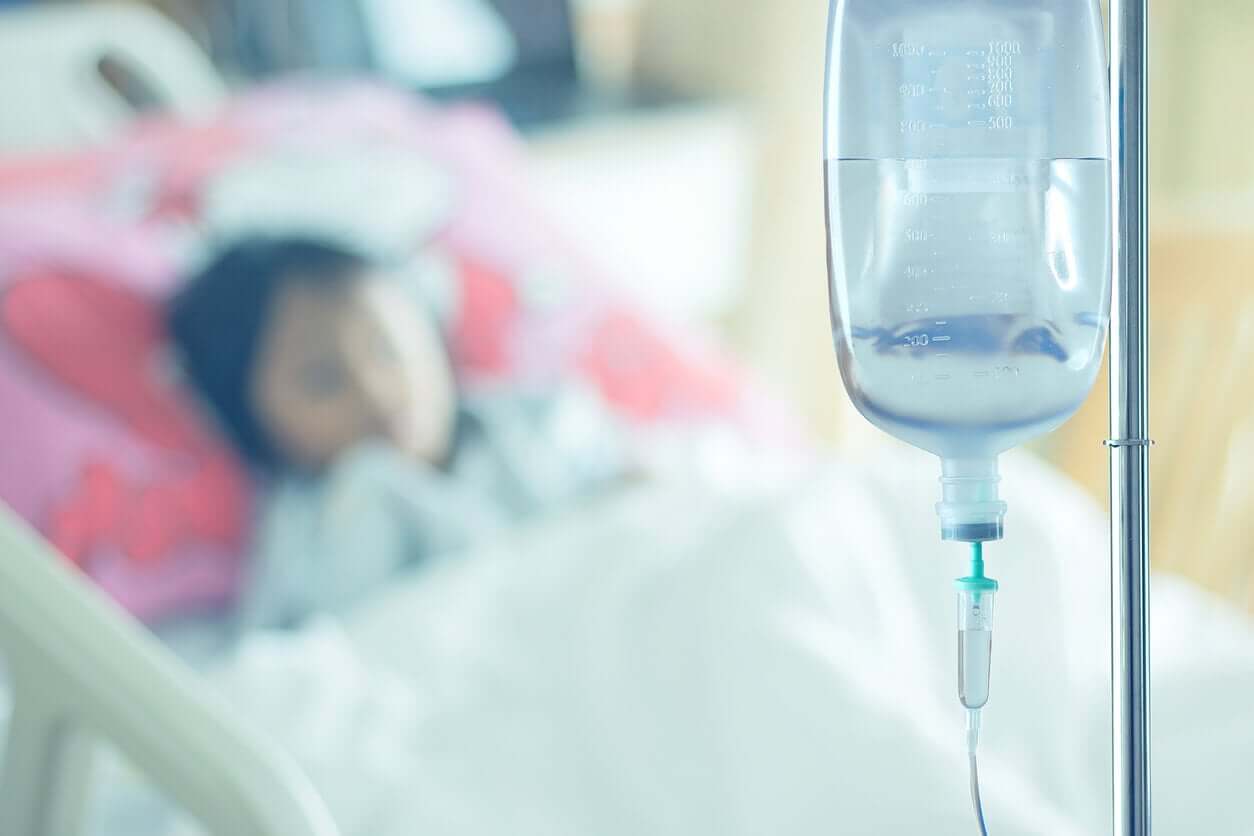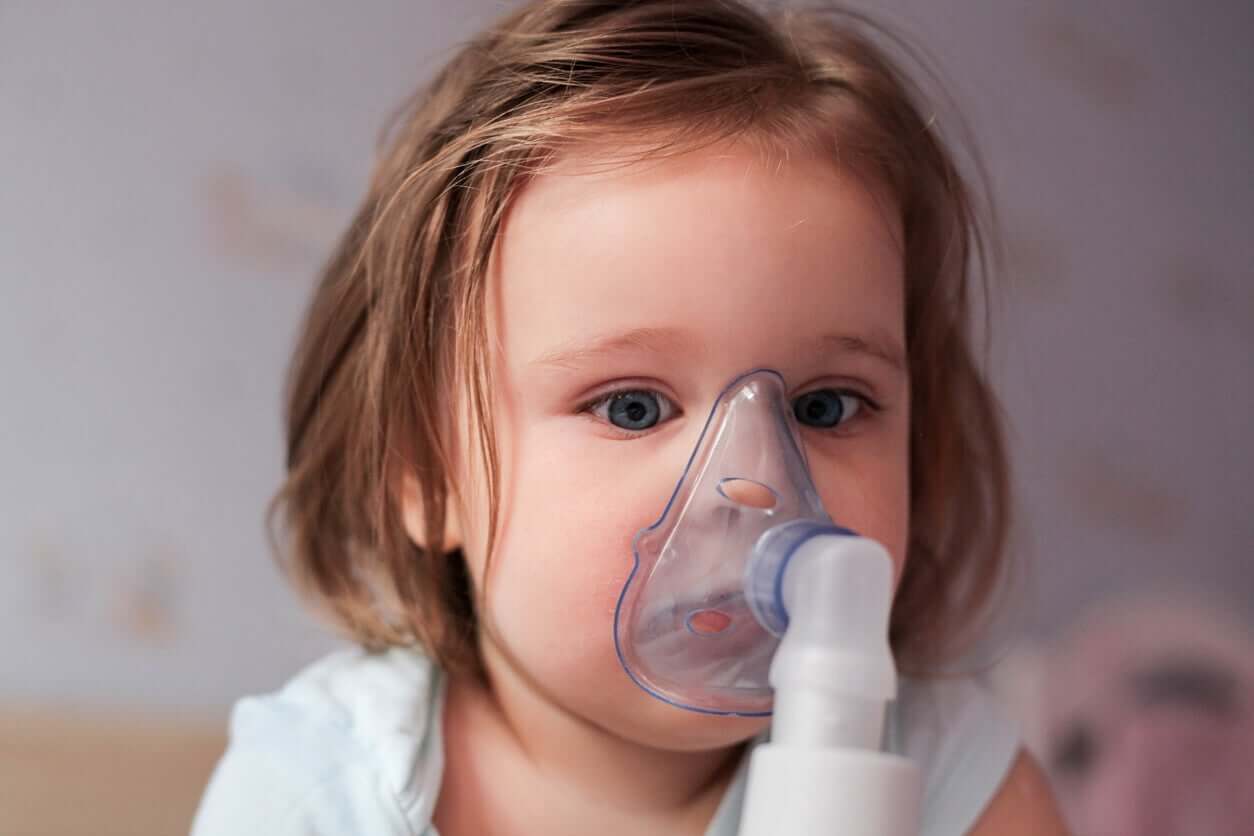What Is Physiological Saline for Babies and Children?

Physiological saline is a medicinal liquid that simulates the plasma contained in our blood. It also goes by the names of isotonic saline solution or physiological solution.
In the field of health, this fluid has various purposes, due to its properties and composition. Keep reading and find out what they are.
What is physiological saline?
As we mentioned earlier, this serum is a solution in a liquid state that tries to reproduce some properties of blood plasma. For this reason, it is composed of water and some minerals, in concentrations equivalent to those of human fluid.
The physiological serum is also called isotonic solution or 0.9% saline solution, due to the amount of sodium contained in it: it is composed of 9 grams of sodium chloride for each liter of water.
When to use physiological saline
Physiological saline is a widely used pharmaceutical product in the field of health.
On some occasions, it collaborates with the resuscitation measures that doctors use in the face of very severe conditions that compromise life. But in others, it’s a very simple and effective alternative for the management of mild illnesses at home.
Next, we’ll describe some of its most common uses.
The replacement of body fluids

Isotonic saline is very helpful when you need to replace fluid losses from the body. For example, in cases of dehydration, bleeding, or a severe infection that destabilizes the body (sepsis).
In most of these examples, the clinical picture is of considerable severity. For this reason, health professionals usually administer it through the veins (intravenously) and in a hospital setting. This is known as fluid therapy.
Wound cleaning
When an injury to the skin occurs, wound care is critical in order to avoid more severe complications, such as infections. So, the initial washing of this tissue plays a fundamental role.
For many years, experts recommended performing these cleanings with sterile physiological saline. Not only because it’s innocuous (it doesn’t cause pain or irritation), but also because it’s a germ-free fluid.
At present, scientific evidence maintains that there are no significant differences in the risk of infection when using saline or tap water. Therefore, the choice to use saline solution to clean wounds is subject to the preferences of each family.
Read more: Antiseptics and Disinfectants for Children’s Wounds
Nasal washes in the context of a cold
Nasal congestion due to colds is a very common childhood symptom. In addition to being annoying, it causes an obstruction in the nose that’s capable of conditioning the breathing of small babies. For this reason, nasal washes with physiological saline are an alternative for the relief of infants.
This practice is very simple to carry out at home and, in general, children tolerate it very well.
It involves placing 1 to 2 milliliters of physiological saline in each nostril (one at a time), with the aim of softening the secretions from the nose and promoting their release. After a few minutes, caregivers can use a manual nasal aspirator to gently aspirate the mucous or allow it to flow down the throat for the child to swallow.
The use of these solutions in this context has proven to be a safe, effective, and useful method to limit the unnecessary consumption of various drugs.
You may be interested in: Nasal Hygiene in Babies: 6 Key Factors
Nebulizations for the treatment of lower airway conditions
When children require medication to treat lower airway conditions, nebulizations are a good alternative to achieve this:
- In the case of laryngitis, nebulizations with saline and inhaled corticosteroids or adrenaline improve inflammation and unpleasant symptoms.
- In the case of bronchiolitis, the effectiveness of nebulizations is a controversial issue.
According to a systematic review by the Cochrane Collaboration, nebulizations with hypertonic saline modestly reduced the risk of hospitalization for these children. Likewise, they shortened the hospital stay in some cases of moderate to severe bronchiolitis.
However, this effect hasn’t been proven with the use of isotonic physiological saline.

Other uses of physiological saline
Saline solution is also useful in order to clean the eye secretions of infants, due to its condition as a sterile (germ-free) fluid. However, mothers can also use their breast milk, which isn’t completely free of microorganisms.
About the importance of physiological saline for health
Saline is a very useful medication. In addition, it’s generally an inexpensive product that children and their families tolerate well and that’s safe enough for home use.
In any case, before using it, it’s good to talk to your pediatrician. The professional will be the one who determines the convenience of its use and indicates the most appropriate mode of administration according to each case.
Physiological saline is a medicinal liquid that simulates the plasma contained in our blood. It also goes by the names of isotonic saline solution or physiological solution.
In the field of health, this fluid has various purposes, due to its properties and composition. Keep reading and find out what they are.
What is physiological saline?
As we mentioned earlier, this serum is a solution in a liquid state that tries to reproduce some properties of blood plasma. For this reason, it is composed of water and some minerals, in concentrations equivalent to those of human fluid.
The physiological serum is also called isotonic solution or 0.9% saline solution, due to the amount of sodium contained in it: it is composed of 9 grams of sodium chloride for each liter of water.
When to use physiological saline
Physiological saline is a widely used pharmaceutical product in the field of health.
On some occasions, it collaborates with the resuscitation measures that doctors use in the face of very severe conditions that compromise life. But in others, it’s a very simple and effective alternative for the management of mild illnesses at home.
Next, we’ll describe some of its most common uses.
The replacement of body fluids

Isotonic saline is very helpful when you need to replace fluid losses from the body. For example, in cases of dehydration, bleeding, or a severe infection that destabilizes the body (sepsis).
In most of these examples, the clinical picture is of considerable severity. For this reason, health professionals usually administer it through the veins (intravenously) and in a hospital setting. This is known as fluid therapy.
Wound cleaning
When an injury to the skin occurs, wound care is critical in order to avoid more severe complications, such as infections. So, the initial washing of this tissue plays a fundamental role.
For many years, experts recommended performing these cleanings with sterile physiological saline. Not only because it’s innocuous (it doesn’t cause pain or irritation), but also because it’s a germ-free fluid.
At present, scientific evidence maintains that there are no significant differences in the risk of infection when using saline or tap water. Therefore, the choice to use saline solution to clean wounds is subject to the preferences of each family.
Read more: Antiseptics and Disinfectants for Children’s Wounds
Nasal washes in the context of a cold
Nasal congestion due to colds is a very common childhood symptom. In addition to being annoying, it causes an obstruction in the nose that’s capable of conditioning the breathing of small babies. For this reason, nasal washes with physiological saline are an alternative for the relief of infants.
This practice is very simple to carry out at home and, in general, children tolerate it very well.
It involves placing 1 to 2 milliliters of physiological saline in each nostril (one at a time), with the aim of softening the secretions from the nose and promoting their release. After a few minutes, caregivers can use a manual nasal aspirator to gently aspirate the mucous or allow it to flow down the throat for the child to swallow.
The use of these solutions in this context has proven to be a safe, effective, and useful method to limit the unnecessary consumption of various drugs.
You may be interested in: Nasal Hygiene in Babies: 6 Key Factors
Nebulizations for the treatment of lower airway conditions
When children require medication to treat lower airway conditions, nebulizations are a good alternative to achieve this:
- In the case of laryngitis, nebulizations with saline and inhaled corticosteroids or adrenaline improve inflammation and unpleasant symptoms.
- In the case of bronchiolitis, the effectiveness of nebulizations is a controversial issue.
According to a systematic review by the Cochrane Collaboration, nebulizations with hypertonic saline modestly reduced the risk of hospitalization for these children. Likewise, they shortened the hospital stay in some cases of moderate to severe bronchiolitis.
However, this effect hasn’t been proven with the use of isotonic physiological saline.

Other uses of physiological saline
Saline solution is also useful in order to clean the eye secretions of infants, due to its condition as a sterile (germ-free) fluid. However, mothers can also use their breast milk, which isn’t completely free of microorganisms.
About the importance of physiological saline for health
Saline is a very useful medication. In addition, it’s generally an inexpensive product that children and their families tolerate well and that’s safe enough for home use.
In any case, before using it, it’s good to talk to your pediatrician. The professional will be the one who determines the convenience of its use and indicates the most appropriate mode of administration according to each case.
All cited sources were thoroughly reviewed by our team to ensure their quality, reliability, currency, and validity. The bibliography of this article was considered reliable and of academic or scientific accuracy.
- Valente JH, Forti RJ, Freundlich LF, Zandieh SO, Crain EF. Wound irrigation in children: saline solution or tap water? Ann Emerg Med. 2003 May;41(5):609-16. doi: 10.1067/mem.2003.137. PMID: 12712026. Disponible en: https://pubmed.ncbi.nlm.nih.gov/12712026/
- Alhazzani W, Evans L, Alshamsi F, et al. Surviving Sepsis Campaign Guidelines on the Management of Adults With Coronavirus Disease 2019 (COVID-19) in the ICU: First Update, Critical Care Medicine: March 2021 – Volume 49 – Issue 3 – p e219-e234 doi: 10.1097/CCM.0000000000004899. Disponible en: https://journals.lww.com/ccmjournal/Fulltext/2021/03000/Surviving_Sepsis_Campaign_Guidelines_on_the.21.aspx
- Chirico G, Beccagutti F. Nasal obstruction in neonates and infants. Minerva Pediatr. 2010 Oct;62(5):499-505. PMID: 20940683. Disponible en: https://pubmed.ncbi.nlm.nih.gov/20940683/
- Zhang L, Mendoza-Sassi RA, Wainwright C, Klassen TP. Nebulised hypertonic saline solution for acute bronchiolitis in infants. Cochrane Database Syst Rev. 2017 Dec 21;12(12):CD006458. doi: 10.1002/14651858.CD006458.pub4. PMID: 29265171; PMCID: PMC6485976. Disponible en: https://pubmed.ncbi.nlm.nih.gov/29265171/
- Chirico G, Quartarone G, Mallefet P. Nasal congestion in infants and children: a literature review on efficacy and safety of non-pharmacological treatments. Minerva Pediatr. 2014 Dec;66(6):549-57. PMID: 25336097. Disponible en: https://pubmed.ncbi.nlm.nih.gov/25336097/
- Fundación para la formación e investigación sanitaria de la región de Murcia. Volviendo a lo básico: fluidoterapia, anexo 4. [Internet] Disponible en: http://www.ffis.es/volviendoalobasico/4anexo_fluidoterapia.html
- Ventosa Rosquelles P, Luaces Cubells C. Diagnóstico y tratamiento de la laringitis en Urgencias.
Protoc diagn ter pediatr. 2020;1:75-82. Disponible en: https://www.aeped.es/sites/default/files/documentos/06_laringitis.pdf
This text is provided for informational purposes only and does not replace consultation with a professional. If in doubt, consult your specialist.








